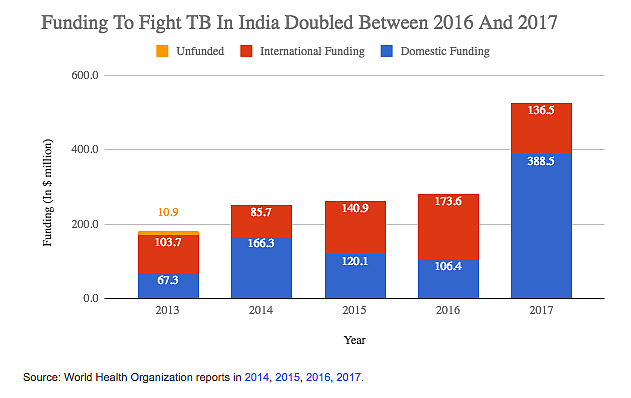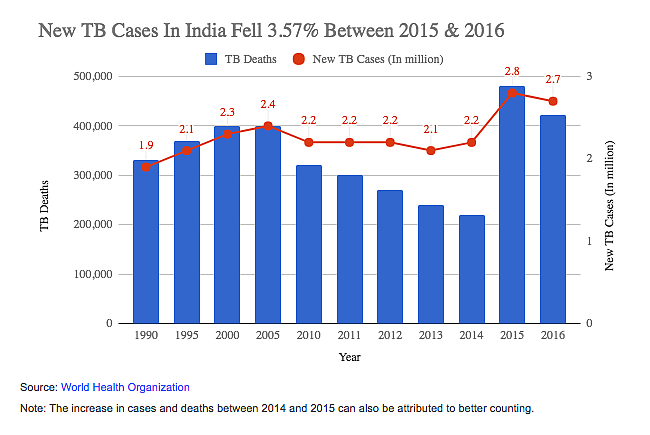The seeds of many positive changes were sown in 2017 and could bring news to cheer Indians in 2018. The country stepped up its battle against tuberculosis and the number of those affected by the most widespread infectious disease in India may fall. The fall in infant and maternal mortality rates seen in 2017 may improve further over the new year.
The government declared its intention take on the problem of scavenger deaths that hit 102 in 2017 by monitoring the problem more closely and penalising negligent contractors more severely. And the Supreme Court verdict on right to privacy could have an impact on how we look at many personal freedoms.
1. Govt’s Renewed Fight Against TB, Most Widespread Infectious Disease in India
The government, in March 2017, increased its focus on tuberculosis (TB) – a preventable airborne infectious disease that killed 423,000 Indians in 2016 – with the release of the National Strategic Plan for Elimination of Tuberculosis.
The plan is to reduce the incidence of TB from 217 new cases per 1,00,000 in 2015 to fewer than 44 new cases by 2025. As part of this plan, funding for TB prevention and care doubled from $280 million in 2016 to $525 million in 2017.

The government also changed the TB treatment drug regimen – from multiple drugs at a time to a single daily dose in a fixed dose combination. Daily doses are considered more effective than alternate day doses of several pills as recommended earlier by the government’s Revised National Tuberculosis Control Programme.
The government also introduced flavoured fixed dose medicines for children, in 100 pilots across the country, according to this article in The Hindu.
Further, the government started rolling out universal drug sensitivity testing for all TB patients to detect drug resistance to rifampicin, the main anti-TB drug, as reported by The Hindu. This will be aided by the increase in the number of cartridge-based Nucleic Acid Amplification Test machines which help detect drug-resistant TB.
India has a long way to go in eliminating tuberculosis, new cases of which reduced to 2.7 million in 2016, down 3.57 percent from 2.8 million in 2015, according to data from the World Health Organization.
To achieve its goal of TB elimination, India needs to reduce its incidence by 10 percent every year, as IndiaSpend reported in November 2017. For this, the government needs to include the private sector which treats at least half of the TB cases in the country. It also needs to improve treatment completion and cure rates through counselling, offer social support to TB patients, and actively find patients in high-risk communities.

2. Declining Infant, Maternal Mortality
In 2016, there were 90,000 fewer infants deaths than 2015 and the infant mortality rate too declined by 8 percent in the same period, IndiaSpend reported in September 2017.
The gender disparity in infant deaths is also closing; in 2016, the infant mortality rate was 33 per 1,000 for boys and 36 per 1,000 for girls; in 2015, the figures were 35 and 39 respectively, the difference between the genders was less than 10 percent.
There were reductions in maternal mortality too. By 2013, India’s maternal mortality ratio was lower than the global average. From 254 deaths per 100,000 live births in 2004-06, the ratio fell to 167 in 2013. The global average in 2016 remained higher at 179.
The percentage of institutional deliveries in India rose – from 39 percent in 2005-06 to 79 percent in 2015-16, according to the National Family Health Survey data. But infant mortality and under-five mortality were higher than global average, IndiaSpend reported in September 2017.
India prevented 1 million deaths among children under five years of age between 2005 and 2015. Three million more deaths could have been prevented had all of India performed as well as some states, IndiaSpend reported in September 2017.
Interventions, including timely treatment of diarrhoea, vaccinations for tetanus and measles, and an increase in hospital births enabled this improvement, said experts.
India’s next challenge is to meet the 2030 Sustainable Development Goals on child and neonatal mortality. These goals were agreed upon under the United Nations Development Programme and involve the reduction of child mortality to 25 per 1,000 live births and neonatal mortality to 12 per 1,000 live births.
This would require an average annual decline of 4.1 percent in child mortality and 5.3 percent in neonatal mortality from 2015 onwards. India could achieve this by improving education, antenatal care and nutrition, and reducing maternal anaemia and tobacco use, as mentioned earlier.
3. Govt Plans to Begin Scavenger Count, Penalise Contractors for Deaths
In 2017, a year that saw about nine deaths every month because of manual scavenging, India finally decided to have an official count of how many people clean sewer lines in violation of laws banning such practices.
In 2017, 102 workers were reported to have died while cleaning sewer lines manually, a task banned in 1993 by the Employment of Manual Scavengers and Construction of Dry Latrines (Prohibition) Act. The penalties on scavenging increased in 2013 through the Prohibition of Employment as Manual Scavengers and their Rehabilitation Act.
On 21 March 2017, Safai Karmachari Andolan (Sanitation Workers’ Movement) wrote to the home ministry to direct the National Crime Records Bureau to count such deaths separately, Newsclick reported on 28 March 2017. The Andolan is a body that fights the practice of forcing dalits, lowest on the Hindu caste hierarchy, to clean others’ excreta.
The National Safai Karmacharis Finance and Development Corporation–a not-for-profit under the social justice ministry incorporated on 24 January 1997, to help sanitation workers get out of manual scavenging – will survey 15 major states over six months to determine how many are still trapped in scavenging. This was decided by social justice minister Thaawar Chand Gehlot on 14 November 2017, Scroll.in reported on 15 November 2017.
The number of people forced to clean latrines manually remains unclear.
As many as 1,80,000 people still clean latrines manually. Of this, 1,470 have died since 2010, claimed Safai Karmachari Andolan’s Bezwada Wilson, winner of the 2016 Ramon Magsaysay award, as per this The New Indian Express report on 10 October 2017.
States claim there are about 13,000 manual scavengers, of whom 270 have died, according to data presented to social justice minister Gehlot on 14 November 2017, according to the Scroll.in report.
State governments have to pay Rs 10 lakh to families of workers who die while cleaning sewers, according to a March 27, 2014, Supreme Court order. The government is set to mandate that contractors and private individuals also pay another Rs 10 lakh each to such families, according to the Scroll.in report.
The Swachh Bharat Abhiyan (Clean India Campaign), the Modi government’s sanitation scheme launched on 2 October 2014, had increased the workload on sanitation workers without any improvement in their lives, Milind Ranade, general secretary of Mumbai’s sanitation workers’ union, told IndiaSpend on 17 June 2017.
4. Verdict on Right to Privacy Could Impact Many Personal Freedoms
In a historic verdict, a nine-judge constitution bench of the Supreme Court ruled the right to privacy is a fundamental right under the Indian Constitution on 24 August 2017.
“The right to privacy is protected as an intrinsic part of the right to life and personal liberty under Article 21 and as a part of the freedoms guaranteed by Part III of the Constitution,” wrote Justice JS Khehar, then chief justice of India (CJI), heading the constitution bench.
This ruling holds significance for the future of Aadhaar, the government’s 12-digit biometric identification programme that intends to link with all schemes and services citizens avail of, as IndiaSpend reported on 30 March 2017.
The SC has yet to rule on a clutch of petitions challenging the Aadhaar bill. In the meantime, the government continues to mandatorily link bank accounts, mobile services and welfare schemes to Aadhaar. This is despite the apex court’s right to privacy verdict and an interim order it formerly issued in 2015 that held Aadhaar enrolment voluntary.
In a recent hearing on the matter, the SC extended the deadline for Aadhaar linking by three months to 31 March 2018, the Mint reported on 16 December 2017.
Chief Justice Dipak Misra observed that the court’s earlier orders were passed based on the government’s executive decisions, and now needed to be tested against the Aadhaar Act notified on 26 March 2016. The apex court will begin hearing final arguments on the programme’s legality on 17 January 2017.
Various sections of civil society have opposed the Aadhaar programme over privacy and security concerns. Personal information obtained under the programme could be misused and deprived sections of the the Indian population without access to Aadhaar enrolment may be further marginalised, they have pointed out.
Apart from the Aadhaar programme, the right to privacy judgement is also likely to affect future judgements on cases related to freedom of sexual orientation, right to eat what one wants to, right to medically terminate a pregnancy, freedom to criticise the government and right to control dissemination of personal information in the physical and virtual world, among others as IndiaSpend reported on 24 August 2017.
In arguing the fundamental nature of the right to privacy, the constitution bench also referred to the diverse contexts of previous cases that ranged from telephone tapping, to disclosure of HIV status, food preferences and animal slaughter, scientific tests in criminal investigation, disclosure of bank accounts held overseas, and transgender rights.
(At The Quint, we are answerable only to our audience. Play an active role in shaping our journalism by becoming a member. Because the truth is worth it.)
